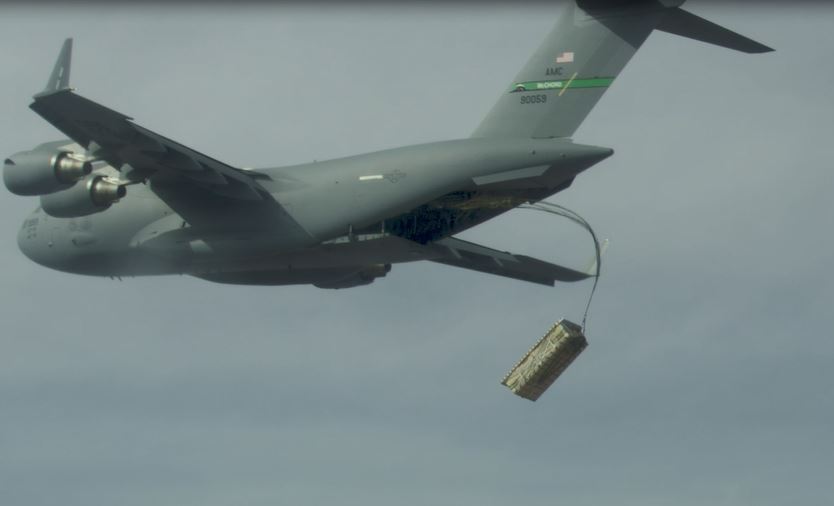Air Mobility Command has big plans to overhaul its gray-tailed heavies for the high-end fight, turning airlifters into command and control assets and possibly putting air-to-air missiles on tankers.
The long-term planning is a shift away from the idea of keeping mobility assets away from a fight, using them instead just as delivery platforms for other combat forces.
AMC boss Gen. Jacqueline D. Van Ovost addressed concerns about the future of mobility and the idea of doing “something out of the box,” during a March 31 Mitchell Institute for Aerospace Studies event, saying, “Why wouldn’t we?”
“Why wouldn’t we change the calculus by doing different things, moving away from the antiquated view that AMC just brings stuff when they’re called … to be a maneuver force inside the threat ring,” Van Ovost asked.
Several exercises and training events have shown that aircraft such as C-17s, KC-135s, and KC-46s have these capabilities. During an advanced battle management demonstration last year, a C-17 dropped Joint Air-to-Surface Standoff Missiles using a roll-on pallet. The idea is that instead of dropping weapons at a forward base to then be loaded on a bomber, the C-17 itself can drop the weapon in the air and Air Force Global Strike Command crews would then be in charge of command and control once it leaves the aircraft, Van Ovost said.
AMC will test having the C2 control on the airplane itself in an upcoming ABMS demonstration, she said.
“Instead of dropping them on a ramp somewhere at some island, we’re just dropping them in the sky, and after they drop out of the sky, someone else lights them off and takes them to the target,” she said.
AMC is looking forward to attritable systems, such as the Defense Advanced Research Projects Agency’s Gremlins small unmanned aircraft, to show how C-5s and C-17s could launch these types of systems for both offensive and defensive counter air. The Gremlins can “actually be recaptured and rearmed on board,” she added.
As part of the ABMS experiment last year, an AMC C-17 used its on-board antennas and other systems to direct a Marine Corps High Mobility Artillery Rocket System. In that scenario, the artillery system rolled off the C-17, received its target information from the aircraft’s system, fired, and rolled back to “move before getting killed,” she said.
The command’s newest aircraft, the KC-46 tanker, has been selected to carry the first released system as part of the ABMS effort—a pod that can be strapped on to provide resilient command and control. The aircraft was picked because it “has the pipes, it’s got antennas” that are ready for the system, she said, though the KC-135 could likely get a system like it in the future.
In a fight, the tankers will need to be flying near the action anyway, supporting fighters, so using them as a command-and-control system, either as the primary or a resilient backup, just makes sense, Van Ovost said.
“When I think about where our airplanes are, they are forward in the fight. So, why wouldn’t we put a capability that’s a pod that fits on the airplane, or that rolls on the airplane, because we have the size, weight, and power to do it and we’re out there anyway,” Van Ovost said.
In a high-end fight, mobility aircraft will be targets and will need improved defensive systems beyond the existing countermeasures. Aircraft such as the C-17 and KC-46 already have hardpoints on their wings, so it is “not a stretch to think that we could put one or two missiles on there for self defense for ourselves.”
AMC is preparing for its largest exercise, Mobility Guardian 21, next month, which will further demonstrate some of the new capabilities and tactics. This year’s version is scheduled to take place in multiple locations in the northern United States, with the focal point on the Alpena Combat Readiness Training Center in Michigan, where the main scenario will focus on humanitarian assistance and disaster relief in a contested environment. The 2021 event will be smaller than previous iterations, with about 1,500 personnel from five major commands and representatives from other services.
The exercise will include field artillery, defensive counter air, cyber threats, and other scenarios. AMC crews will need to enter a contested area, provide humanitarian assistance, get out, and then transmit data forward, Van Ovost said.
“We’re doing the pieces, we’re not going to solve everything at once,” she said. “But what we want to know is, in these experiments and in these future games where these are playing, do they make a difference? And so, we’re going after that analytically, and some of the key problems we have to solve to get there, and from that we’ll learn whether or not we want to proceed.”
